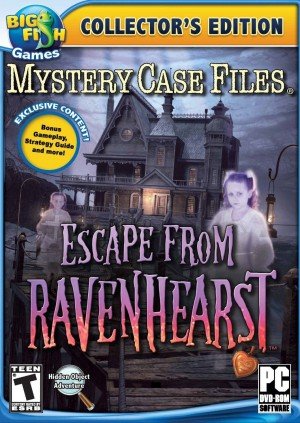Casual Collection - November 2011 releases

Our final – yes, FINAL – Casual Collection features a couple of heavy hitters, as Big Fish's own Mystery Case Files and Azada franchises get hotly-anticipated sequels (the latter in the hands of a different but very familiar developer). Of course there's much more than that, as you'll once again have the opportunity to explore eerie accursed towns and haunted palatial homes; travel to and from the past, manipulating the time stream as you go; confront bloodthirsty Knights Templars; match wits against psychotic masked villains; and even scour the frozen Himalayas for evidence of Lovecraft's Elder Gods and their deadly Shoggoth slaves. The themes may be nothing new, but this month's releases include some of the most grisly, disturbing scenarios ever to darken the casual realm. So if you're ready to get your creep on, take your pick(s) of the best from the following lineup:
Page 1: Mystery Case Files: Escape from Ravenhearst
Page 2: Azada: In Libro, The Keepers: Lost Progeny
Page 3: Time Mysteries: The Ancient Spectres, Hallowed Legends: Templar
Page 4: Haunted Manor: Queen of Death, Shattered Minds: Masquerade
Page 5: Death Under Tuscan Skies: A Dana Knightstone Novel, Mystery Stories: Mountains of Madness
Note: Not to be upstaged, The Jolly Gang’s Misadventures in Africa, Red Crow Mysteries: Legion, and Cardboard Castle all arrived in November as well, but each will be getting a full review of their own down the road.
Mystery Case Files: Escape from Ravenhearst
by Jack Allin
The Mystery Case Files series has always been on the cutting edge of innovation in the casual realm, as demonstrated by the ever-evolving Ravenhearst series. The first game was a traditional hidden object hunt, while the sequel was one of the earliest, most influential pioneers in introducing significant adventure elements for a more fully-rounded experience. Now Big Fish’s flagship series returns to the stormy English coast in Escape from Ravenhearst, looking to once again push the envelope in new and interesting ways. Consider the attempt half-successful. Even in a genre overloaded with haunted towns, insane antagonists, and creepy environments, this game blows its contemporaries out of water with its deliciously sadistic settings and truly disturbing atmosphere. The gameplay and accessibility both take a notable step back, however, making for a frustrating adventure at times.
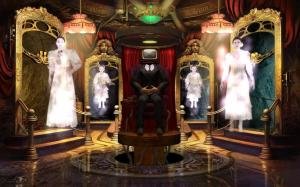 You may have thought you’d seen the last of the deranged Charles Dalimar in Return to Ravenhearst, but you’re lured right back into his snare again along with the ghosts you previously freed. This time your nemesis is determined to make you understand him; to appreciate the torment and pain that drove him to be the monster he is. And boy, is he convincing. Dalimar has recreated the scenes of his life’s most traumatic moments to live through yourself, from a troubled birth in a decrepit hospital to a childhood of servitude to a punishing beast of a mother, followed by his stay at the asylum where he learned to embrace his insanity. If not for the whole “trying to kill and/or capture your soul for all eternity” thing, it’d be easy to pity the man. Considering the perversely malicious villain he became, it’s a credit to the developers that his tragic story feels so intensely human.
You may have thought you’d seen the last of the deranged Charles Dalimar in Return to Ravenhearst, but you’re lured right back into his snare again along with the ghosts you previously freed. This time your nemesis is determined to make you understand him; to appreciate the torment and pain that drove him to be the monster he is. And boy, is he convincing. Dalimar has recreated the scenes of his life’s most traumatic moments to live through yourself, from a troubled birth in a decrepit hospital to a childhood of servitude to a punishing beast of a mother, followed by his stay at the asylum where he learned to embrace his insanity. If not for the whole “trying to kill and/or capture your soul for all eternity” thing, it’d be easy to pity the man. Considering the perversely malicious villain he became, it’s a credit to the developers that his tragic story feels so intensely human.
But is it ever twisted – gloriously so. Dozens of mannequins were harmed in the making of this adventure, often in alarming ways. There are pregnant women with pulsating bellies, babies to X-ray, drowned limbs sticking out of a bathtub, non-anaesthetized operations in progress, mental patients beating their heads on a wall, and a little boy forever suspended under an automated spank-o-tronic. Not shocking enough? Then how about euthanizing patients or attending to the grotesque, obese woman who demands her nightly toenail-clipping, nose hair-trimming and pimple-popping. Yum! And yet, despite all the disgusting imagery, it’s all very “tastefully” done. You’ll feel horrified but not repulsed… or maybe repulsed but not offended. Okay, some will probably be offended anyway, but this genuinely feels like a staged descent into the mind of a madman. Virtually every scene has some new freakish atrocity, and I was eager to continue exploring. Kudos to Big Fish for pulling no punches, while still maintaining an appropriate level of decorum. This game is not bloody or gory or scary, just wonderfully, relentlessly macabre.
All this ugliness sure does look good, too. With an option for high-definition graphics for added crispness, the technical quality matches the detailed realism and artistry, though for some reason the game runs in letterboxed format throughout, even on a widescreen monitor. I groaned at the overused purple hues of the opening nighttime scenes at the now demolished Ravenhearst manor and surrounding coastline, but the locations diverge nicely once you begin to investigate Dalimar’s past. Like the last game, live actors have been integrated into the backgrounds, in particularly effective ways. Dalimar’s face appears on televised mannequin heads to encourage and taunt your efforts, and his past ghostly victims look particularly distressing, imprisoned in liquid holding tanks. The acting is all well done, though Dalimar’s exaggerated performance might be a little over-the-top. Then again, he’s a complete nutjob, so maybe not. Music is kept to a minimum, adding just a touch of discordant ambience at times, while sound effects are convincing, apart from the whimpering cries for help from people you never see or find occasion to rescue.
If only Escape from Ravenhearst were a movie, I could praise it without reservation, but it stumbles badly when it comes to gameplay. The most notable change from previous games is the shift from standard hidden object scenes to “morphing” items this time around, where objects subtly transition from one form to another. Other games have used this technique as a bonus extra, but here it’s the main item scavenging staple. Unfortunately, some of the changes are very tiny and practically indiscernible even when you’re looking right at them. Staring at every inch of the screen for five seconds in the hope you might catch one gets old in a hurry. The morph searches appear right in the main environments, and are quite cleverly explained as the influence of ghosts trying to help you. Mind you, it’s never explained why they need these items collected before they’re able to do so. I’m not so much opposed to the morphing mechanic in general, but a less demanding implementation would have been better. Fortunately, they don’t occur too often, and none are repeated.
Then again, “demanding” applies to the rest of the puzzles as well, as some are very difficult. Codes routinely involve clues acquired from multiple sources, and even then require proper alignment to complete. Even the standalone logic puzzles and minigames are more challenging than usual. Some are quite clever, like a number-based crossword with dice and channeling rotating numbers through a math-based grid, but don’t be surprised to spend lengthy stretches solving a card suit sequencing task or grouping numerical grid tiles. A “simple” memory game spent poking eyes gets ridiculously complicated by the end, and if you make one mistake, you start all over from the beginning. One puzzle in particular is a four-part nightmare. Each task is completely different and none of the steps are explained – no puzzle offers any instructions whatsoever – and though you can solve them in any order, you can only skip the entire thing, not a particular stage. Both a tricky chess puzzle and an absurdly unintuitive sequence puzzle tripped me up, and I eventually gave up in disgust.
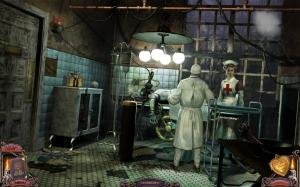 If you think you can minimize the challenge with an easier setting, think again, as there are no difficulty options to choose from. In fact, the game goes out of its way to be as unhelpful as possible. There is no hint system of any kind outside of the morphing scenes, and even the journal fails to record pertinent information! Since clues can be anywhere, some of them quite obscure, the least the game can do is note them for later reference. But no, expect to be pulling out your own pad of paper to jot down periodic table numbers and arrow alignments, among others. THIS is a “casual” game? Shockingly, even the strategy guide in the Collector’s Edition is ridiculously obtuse. It consists solely of pictures, and while you can usually figure out what it’s getting at, who wants to work at understanding the help they’ve just paid double the money to acquire?
If you think you can minimize the challenge with an easier setting, think again, as there are no difficulty options to choose from. In fact, the game goes out of its way to be as unhelpful as possible. There is no hint system of any kind outside of the morphing scenes, and even the journal fails to record pertinent information! Since clues can be anywhere, some of them quite obscure, the least the game can do is note them for later reference. But no, expect to be pulling out your own pad of paper to jot down periodic table numbers and arrow alignments, among others. THIS is a “casual” game? Shockingly, even the strategy guide in the Collector’s Edition is ridiculously obtuse. It consists solely of pictures, and while you can usually figure out what it’s getting at, who wants to work at understanding the help they’ve just paid double the money to acquire?
Oh sure, there’s some “bonus” content in the extended version as well, but it’s appallingly inadequate. Rather than giving you an additional chapter, all you get are a few built-in hidden object activities. The main one involves matching tiny snippets of scenery to their real-world counterparts, which is extremely tough in some instances, while the journal also includes morphing objects to find. Oh, so THAT’s what it’s for! Certainly isn’t to do what a journal is supposed to do. Needless to say, you’re better off with the standard version, since the main game plays out exactly the same either way.
It’s easy to love or hate a game, but rarely do I love and hate the same game at the same time, but that’s increasingly how I felt as I progressed through this one. I relished the sick abominations of a troubled mind, and the production values are second to none in the casual realm. But while I applaud the attempt to try new things, and even enjoyed the morphing scenes for the most part, at least two or three items per screen felt more than a little unfair. And I’m all for meaty, challenging puzzles, but not without any of the user-friendly help options that casual gamers have come to expect. One thing’s for sure: you’ll get your (standard edition’s) money’s worth from the latest Mystery Case Files adventure, as it can easily take six hours or (many) more to get through it all. It’s a thrilling world to revisit, but as the difficulty ramps up, you’ll probably be eager to Escape from Ravenhearst before all is said and done, not always for the reasons intended.
Azada: In Libro
by Jack Allin
The more casual games become adventurey, the less hidden object searches seem to fit the new style. Increasingly I’ve been wondering what it would be like if a developer simply removed the scavenger hunts altogether. Azada: In Libro does precisely that, offering a pure adventure experience, albeit still with some traditional casual helps like puzzle skips, hint systems, and difficulty levels. The good news is, this formula works fairly well; the bad news is, it comes at the expense of what made the previous Azada games so whimsically entertaining. This is a darker, sprawling, relatively complex adventure set across three troubled worlds cursed by a power-mad magician. For reasons unknown, only you can stop him (after being duped and essentially kidnapped for the privilege) by collecting the keys that lead to his destination. This is more like Azada-meets-ERS Game Studios… which, of course, is exactly what it is, as the franchise torch has been passed on this time around.
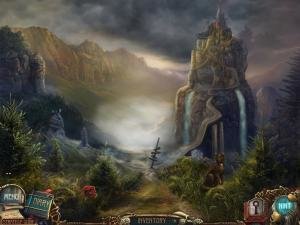 The story in Azada has always been threadbare, but it worked better in the more streamlined first two games. Here there’s so much open exploring to do, and so little actual information about the bizarre fantasy worlds to learn along the way. The three distinct areas consist of a deserted harbour town with docked ships and railcars to investigate; a fantasy valley with fairy village, tainted forests and mountain towers; and a lava-lined hellish canyon with deadly crevasses and rickety staircases. None of them on their own bring anything new to the table, but together they make for a wonderfully diverse adventure. And this being an ERS game, there are plenty of macabre touches. The inhabitants of these worlds have suffered different afflictions, each as sudden and fatal as the others, whether being stripped to skeletons by a cyclonic monster or being turned to copper by a living mist. Everywhere you look there are ghosts, demons, giant rats, stone chimeras, and other haunting images, all of them mixed with lovely natural scenery, convincingly depicting a peaceful land suffering an unnatural torment.
The story in Azada has always been threadbare, but it worked better in the more streamlined first two games. Here there’s so much open exploring to do, and so little actual information about the bizarre fantasy worlds to learn along the way. The three distinct areas consist of a deserted harbour town with docked ships and railcars to investigate; a fantasy valley with fairy village, tainted forests and mountain towers; and a lava-lined hellish canyon with deadly crevasses and rickety staircases. None of them on their own bring anything new to the table, but together they make for a wonderfully diverse adventure. And this being an ERS game, there are plenty of macabre touches. The inhabitants of these worlds have suffered different afflictions, each as sudden and fatal as the others, whether being stripped to skeletons by a cyclonic monster or being turned to copper by a living mist. Everywhere you look there are ghosts, demons, giant rats, stone chimeras, and other haunting images, all of them mixed with lovely natural scenery, convincingly depicting a peaceful land suffering an unnatural torment.
Production values are typically high for an ERS game, or perhaps even higher than normal, at least visually. The stage is set by a lengthy dynamic cutscene of a train travelling to Prague, and the eye candy carries over into the vivid hand-drawn backdrops. Ambient animations bring these postcard environments to life, including a couple of inquisitive otherworldly guides that lead the way to your final goal, ever out of reach. The audio doesn’t fare quite so well, however. All major speaking parts are voiced, including Titus, the man who connived to bring you to Azada, and the three guardians of each realm, plus a peculiar mechanical sailor. The acting can be a little stiff, but the bigger problem is that the voices sound muffled, as if they were recorded in a closet. Music plays only sporadically and changes with each new world. Much of it simply blends into the background, at times enhancing the eerie mood with discordant tones and dark orchestrals, though a few jauntier harp pieces are both repetitive and occasionally out of place for the circumstances.
With no hidden object searches to complete… Okay, you could maybe count two screens as such, which task you with identifying sets of items, like zapping all snakes with a repellant to clear the way. The entire rest of the time is spent simply exploring the dozen-plus screens in each world, collecting inventory items the old-fashioned way (sadly including some pixel hunting, even on the easiest difficulty setting, whose sparkles are so brief as to be practically non-existent). Item uses are fairly intuitive, but like most casual games, this one has a tendency to demand only the “right” object when others would seemingly do. They’re also extremely random in their (often inaccessible at first) placement. If you need honey, you won’t go looking for a beehive; you’ll stumble around and jump through hoops until you find it buried where no honey would EVER be. This can lead to clueless wandering – or clued wandering, if you utilize the hint system screen by screen until you find something interactive you’ve overlooked.
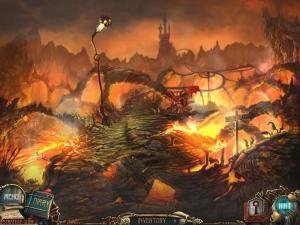
As you attempt to assemble a gun, reconnect a weather tower, or mix potions, often you’ll need to collect multiple items like gears, doll clothes, mechanical bugs, or the entirely unsubtle “puzzle parts”. And indeed there are many puzzles to solve, with a wide range of types and difficulty. Some are entirely standard: jigsaws, misaligned levers, code combinations (requiring clues), and patterned edge-matching, but several are quite clever and far less common. Standouts include moving an expanding spring past obstacles into a prescribed slot and sliding coloured bugs into place on a grid with only a pair of small ledges to use for resistance. Speaking of grids, you’ll also need to cover all symbols with stencils a couple times, and unify multi-coloured balls in limited moves, which can be both challenging and fun. Some unnecessarily complex twiddleware does bung up the proceedings (rotators, okay; sliders, fine – but both together??), and the final Sudoku task feels anything like the climactic moment it ought to be, but for the most part there’s plenty of puzzling value to be found.
All that puzzly goodness should take upwards of four satisfying hours to complete, capped off by a completely unsatisfying ending. The Collector’s Edition offers a much better ending. The problem is, it only adds about a half hour of additional gameplay. There are a few nice new puzzles, like routing your way through a numbered math grid and sliding opposite-moving keys into place, along with an annoying rotating target minigame, but your trip though an unexplained Prague-that-really-isn’t-Prague is over all too soon. It’s games like this that make me resent extended editions, as the standard version feels incomplete and the bonus content isn’t worth double the cost. Still, for the most part you can’t go wrong with either version of this game. If you enjoy puzzles and are getting tired of (or never liked) random hidden object hunts interfering with your adventuring, book your passage on the train bound for Azada: In Libro now.
The Keepers: Lost Progeny
by Merlina McGovern
There’s just something about children, especially children in period costume, that ratchets up the creep factor in just about any scary situation. Take any typical haunted scenario – house, island, anything – throw in a bad seed child, and you’ve got a surefire recipe for spooky fun. The demon boy you meet in Blam! Games’ The Keepers: Lost Progeny isn’t just a bad seed, he’s an entire basket full of bad apples. But he’s only one of a variety of eerie characters that you’ll enjoy getting to know, or getting away from, in this entertaining dark casual game packed full of well-integrated inventory and logic puzzles and fantastically gory artwork.
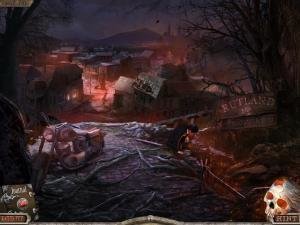 You play an orphan who receives a mysterious package of information that promises to enlighten you about your parents and family history, pointing you in the direction of a small town. You know all is not right with the world, however, when you enter the town of Rutland and see a young boy in old-fashioned clothing squatting and peering into a large crevice in the ground next to a teetering “Rutland Welcomes You” sign. He warns you against going into the devastated town, surrounded by earth cracked open spewing noxious fumes and abandoned homes, but of course it’s the very place you need to explore.
You play an orphan who receives a mysterious package of information that promises to enlighten you about your parents and family history, pointing you in the direction of a small town. You know all is not right with the world, however, when you enter the town of Rutland and see a young boy in old-fashioned clothing squatting and peering into a large crevice in the ground next to a teetering “Rutland Welcomes You” sign. He warns you against going into the devastated town, surrounded by earth cracked open spewing noxious fumes and abandoned homes, but of course it’s the very place you need to explore.
The artwork doesn’t shy away from the grim and gruesome, and it’s the first casual game I’ve played that came with a warning about mature graphic content. One character isn’t just dead in this game, he’s a suicide, which you can see by the revolver in his hand, the blood spilling out of his mouth and splashed on the wall behind him. Another is a cop who’s been burned to a crisp. Ambient animations also ratchet up the tension at times, with motorcycles zooming past you and bursting into flames, a near miss that nearly takes your life. As you investigate scenes of murder and mayhem, flashbacks in scratched film suddenly appear – a woman swinging from a hangman’s noose when you least expect it is sure to leave you squirming with unease.
It’s not just the dead characters who are interesting, either. You’ll get to meet a mysterious hotel owner with a terrible comb-over, the demon child, and a mysterious woman who seems just as fond of blood and pagan rituals as she is of children. All characters are voiced and well acted, and in addition to the morbid artwork, which makes copious use of blood splashes and splatters, the music is a haunting tinkling and singing of violin strings that hovers over you as you explore, adding to the macabre atmosphere of the game.

The inventory puzzles and repeating hidden object scenes are well integrated and often tie into the gory theme of the story. You’re not just finding and combining random items, you’re seeing if a character might like their meal with a side of sedative. You won't just look for something to break through a wall to find some randomly placed object; you’ll discover something much more ghoulish lurking behind those walls that has been placed there for very specific reasons. Hidden object scenes are logical and not overly teeming with clutter. Searching for ties and hats in a closet, bullets and police apparel in a police station, or rats in a coffin makes sense and also fits in with the prevailing themes. You’ll also encounter a wealth of logic puzzles that will not only satisfy any puzzle addict’s craving, but also add to the grim feel of the game, including line-drawing puzzles, where you’ll have to create complicated patterns without crossing a line more than once; a mini-hangman game with a real miniature hanging skeleton; and a lock-picking puzzle adorned with more skeletons than you can shake a stick at.
All of these wonderful puzzles surround a complex story that emerges in the three hours you spend exploring the town of Rutland and your family history. This is a tale that touches on evil forces and people banding together as keepers to keep that evil at bay. The Collector’s Edition provides you with a fantastic set of bonus chapters to play. You’ll attempt to become a keeper in one chapter, while in the other you’ll control a character who is becoming fully evil. These bonus chapters represent one of the more substantial bits of bonus play I’ve encountered in a while, clocking in at more than an hour of extra playing time combined. In addition to setting up future games in the series, the extra chapters add to the mythology hinted at in the ending of the main game. If you’re ready for a good, adult-themed game that piles on the puzzles as well as the gore, you should pick up The Keepers: Lost Progeny and never let go.
Time Mysteries: The Ancient Spectres
by Shuva Raha
Left at an orphanage as an infant, Esther has no link to her origins save an ornate rattle and a medallion, plus frequent nightmares of a strange mansion and an ancient oak tree. On a hazy day in 1830, she receives a letter from a distant aunt urging her to return to her estate, not only to learn more about her illustrious ancestors descended from Merlin the wizard, but also to prevent a power-hungry witch from escaping the magical container built by her family. Artifex Mundi's Time Mysteries: The Ancient Spectres starts in earnest as Esther reaches the abandoned, decrepit mansion – the same one from her nightmares – and discovers the crystal cage which she must keep from cracking by finding magical tokens scattered across Europe and time.
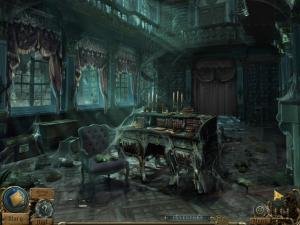 This sequel to Inheritance is loosely linked through the Ambrose family tree: Esther is the grandmother of Vivian, the heroine of the first episode, who travelled through time to rescue her father from the clutches of his kidnapper. But The Ancient Spectres is far superior in both complexity and production quality to its predecessor, which used time travel as a mere plot device to generate diverse visual backdrops. Here, time and space are linked intricately through action and consequence, and Esther must constantly flit between both to achieve her goals, whether collecting items from one century to use in another, setting up events that yield results years later, or gathering clues and objects from past versions of the mansion even as the witch progressively destroys it in the present day.
This sequel to Inheritance is loosely linked through the Ambrose family tree: Esther is the grandmother of Vivian, the heroine of the first episode, who travelled through time to rescue her father from the clutches of his kidnapper. But The Ancient Spectres is far superior in both complexity and production quality to its predecessor, which used time travel as a mere plot device to generate diverse visual backdrops. Here, time and space are linked intricately through action and consequence, and Esther must constantly flit between both to achieve her goals, whether collecting items from one century to use in another, setting up events that yield results years later, or gathering clues and objects from past versions of the mansion even as the witch progressively destroys it in the present day.
The main adventure has about a dozen hidden object screens and as many logic puzzles interspersed with numerous inventory quests to collect tools and puzzle parts, all taking over five hours to complete. The hidden object searches are quite challenging, with attractive, detailed screens smartly stocked with era- and situation-appropriate items, some of which require minor interactivity. These screens are revisited twice each, but all previously collected items are excluded from later searches. Besides the rechargeable hint, a 'sonar' feature helps by showing silhouettes of the listed items. Interestingly, if you don't feel like trawling the search screens, you can opt for an addictive symbol-matching arcade game to move ahead.
The standalone puzzles are simple and cover the usual gamut of jigsaws, rotators, and pattern- or image-matching, but are nevertheless entertaining as they're well-integrated with the story. One that requires lighting a city's streets is especially elegantly designed. The backbone of the game, however, are Esther's tasks to locate objects and create situations by teleporting between the Ambrose estates in London and Venice over multiple centuries using the time machine, like the clever quest to produce a bottle of wine. These add genuine complexity to the linear flow, and the sense of accomplishment as minor activities significantly alter the future is satisfyingly real.
Unlike Vivian, Esther has no wisecracking sidekick; instead she must rely on the letters and instructions strewn about, which are archived in her journal along with her objectives. The time machine also serves as an interactive map, marking out locations – across time – where tasks are pending, and those which have changed since Esther's last visit. By allowing teleportation to specific destinations, this invaluable facility eliminates the tedious legwork that cripples most casual games.
The attention to detail extends from the plot and puzzles into production as well. The richly coloured scenes reflect their eras and moods, such as the Venetian mansion in the grips of the plague or its British counterpart crumbling under the witch's onslaught. Comparing locations through the centuries is a delightful pastime in itself. Ambient animation, like wavering sunbeams and footsteps on dusty floors, is subtle and efficient, as is the orchestral score, which is lovely in parts and ominous in others. Cutscenes are spectacular, be it Esther's nightmares, the witch running amok, or the release of fire-moths from the crystal cage. The time machine animation is also sleek and never gets stale despite many repetitions. Unfortunately, the screens are annoyingly cluttered with multiple hotspots (and repetitive comments) for non-essential elements that are never deactivated, resulting in a lot of extra clicks. Conversations and cutscenes are expertly voiced, though in-game commentary is text-based, with coherent, easy-to-follow dialogues.
 While the main game ends with a blazing cliffhanger and the announcement of a sequel, the Collector’s Edition returns to the past for a complicated half hour story of a woman trying to save both infant and adult Esther from her fiery predicament. Along the way, she must repair the time machine, visit an outlandish lab and a herbalist's hut, and solve a handful of easy minigames. A notable exception is a poorly clued, visually and mentally taxing pattern-matching puzzle that may make you grateful for the skip button. The bonus chapter has four more repeating hidden object searches, and is a fairly unnecessary extension of play time unless one is really keen to learn how Esther arrived at the orphanage or manages her predictable present-day escape. A unique extra is an encyclopaedia of key characters and objects, though having it on hand while playing may have made it a more useful reference.
While the main game ends with a blazing cliffhanger and the announcement of a sequel, the Collector’s Edition returns to the past for a complicated half hour story of a woman trying to save both infant and adult Esther from her fiery predicament. Along the way, she must repair the time machine, visit an outlandish lab and a herbalist's hut, and solve a handful of easy minigames. A notable exception is a poorly clued, visually and mentally taxing pattern-matching puzzle that may make you grateful for the skip button. The bonus chapter has four more repeating hidden object searches, and is a fairly unnecessary extension of play time unless one is really keen to learn how Esther arrived at the orphanage or manages her predictable present-day escape. A unique extra is an encyclopaedia of key characters and objects, though having it on hand while playing may have made it a more useful reference.
Time Mysteries: The Ancient Spectres is most certainly another very good game from Artifex Mundi (immediately following the stellar Enigmatis: The Ghosts of Maple Creek). Its fantasy-based story is laid out plausibly and ties in actual historical events, the reasonably challenging gameplay flows smoothly and stays aligned with the plot, and the production is largely superlative. But what elevates it to a great game is the way it links its core time-travel concept into the gameplay to create an experience that is complex and thought-provoking beyond the pretty window-dressing. It connects actions to consequences with rare rationality, and is confident enough of its own potential to avoid deceiving players with unnecessary backtracking and ill-informed quests, making it a casual adventure that's well worth your time.
Hallowed Legends: Templar
by Merlina McGovern
Would you be able to tell the difference between what is good and what is evil? In Elephant Games’ Hallowed Legends: Templar, your ability to make the right choices is put the test as you encounter a variety of people who aren’t exactly what they seem, from possessed Templar knights to a mad man to an ambitious mayor of a small French town. These colorful characters attempt to aid you, or throw you off the track, as you search for your missing brother in a fun-filled journey that will take you through a variety of challenging logic puzzles and hidden object searches.
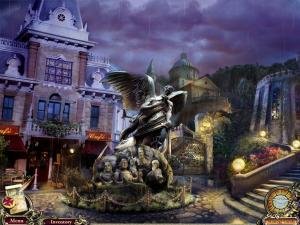 Just as you’ve settled into the small town of Gabelais at the request of your worried sister-in-law, you’ll find yourself attacked by a Templar, or perhaps just someone who likes to dress up in medieval costume. You’ll spend the rest of the game trying to figure out what exactly this and other strange characters from another time and place have to do with your missing brother Carl. Making great use of full-motion video, real actors play out the major roles in the game, including your brother, his wife Helen, a Templar or two, and the town’s mayor.
Just as you’ve settled into the small town of Gabelais at the request of your worried sister-in-law, you’ll find yourself attacked by a Templar, or perhaps just someone who likes to dress up in medieval costume. You’ll spend the rest of the game trying to figure out what exactly this and other strange characters from another time and place have to do with your missing brother Carl. Making great use of full-motion video, real actors play out the major roles in the game, including your brother, his wife Helen, a Templar or two, and the town’s mayor.
The developers have done a fine job of mixing FMV with traditional computer generated graphics: A sudden axe strike on your door results in a shower of wood and splinters as an actor in Templar dress breaks his way through your hotel room. The integration of live-action characters and pre-rendered environments is smooth, and the use of FMV helps set the right tone for this rather grim tale. The murderous Templar knights attempting to stop you are vicious in their attacks, and a Good Samaritan who tries to stop the knights from breaking into your hotel room ends up shot through the chest with an arrow as he attempts to escape from the roof. Complementing this tale of misplaced righteous anger and holy orders gone awry is the rather funereal music, with dense organ chords and reverent choral tones.
While the game’s subject matter often seems to be on another plane of existence, many of the main inventory puzzles are logical and have plausible explanations: A priest worried about the mysterious happenings at his church rushes to lock an object that he may need to use as a last resort in his confessional booth. When you find the poor priest floating dead in an underground tunnel, that same item will come in very handy as you investigate the church – this isn’t just some randomly hidden object with an arbitrary lock; the reason behind its presence makes sense. Several of the inventory puzzles are layered, and you’ll have to search for several objects to create one larger item within a scene itself, which I found a welcome layer of challenge, even on the game’s easiest of three settings.
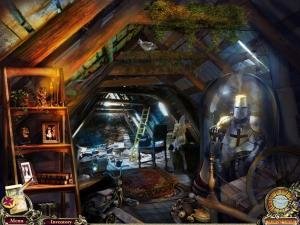
This substantial three-plus hour game also provides a wide variety of logic puzzles, including variations of the usual suspects: tile challenges, Chinese checkers, and rotating ring puzzles. The non-repeating hidden object scenes, however, include some tricky interactive searches. While you’ll have to use some items within the screen itself to find other objects, as indicated on the item list by a different color, you’ll also sometimes have to use regular inventory items as well. This can be more complex, as the list doesn’t give you any color-coded indication when you’ll need to use one, if indeed you even have the needed item at that point.
The game ends on a satisfying, if rather mysterious note. The nearly hour-long Collector’s Edition bonus play fleshes out the mystery of the original ending, and you’ll find yourself back in Gabelais fighting another foe to get the legendary Ark of the Covenant. In a great twist, you’ll get two ways to finish the bonus chapter, a choice that will really make you return to the questions: what is good? What is evil? A compelling storyline fleshed out by clever full-motion video use and entertaining puzzles will keep you happily occupied in this small town filled with an alarming lack of normal citizens. Whether you play the extended edition or not, you’ll have fun with Hallowed Legends: The Templar as it asks you to play the Good Samaritan: Are you up to the task?
Haunted Manor: Queen of Death
by Merlina McGovern
Sibling rivalries can be intense. In Top Evidence Studio’s Haunted Manor: Queen of Death, Christie’s homecoming is marred by a house full of the dead and a creepy sibling, Stella, who takes that rivalry to a whole new level. This dark casual adventure is every bit as morbid as its moniker portends: The queen of death reigns over a manor chock full of deceased or dying people, and you’ll have a grand time exploring the spooky home and its surroundings, though it may leave you less then terrified with an over abundance of poorly placed hidden object scenes.
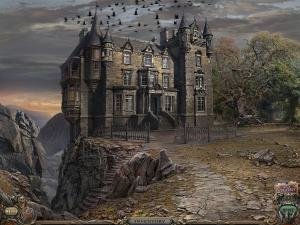 For many years, Christie has been estranged from her twin sister, who was sickly growing up and took up the bulk of her family’s attention. Still, family is family, and when Christie receives an impassioned plea from her sister saying something horrible is haunting the manor and the family is in danger, Christie decides to go home. She’s immediately met with a grim harbinger of things to come when she discovers an overturned carriage on the road, her mother dying within. Something has sucked out her soul, and it’s your job to find out why some monster would do this and try to save the rest of your family in time.
For many years, Christie has been estranged from her twin sister, who was sickly growing up and took up the bulk of her family’s attention. Still, family is family, and when Christie receives an impassioned plea from her sister saying something horrible is haunting the manor and the family is in danger, Christie decides to go home. She’s immediately met with a grim harbinger of things to come when she discovers an overturned carriage on the road, her mother dying within. Something has sucked out her soul, and it’s your job to find out why some monster would do this and try to save the rest of your family in time.
Unfortunately, the lifelessness seems to extend from the premise to the rudimentary animations. A murder of crows circling over the castle are roughly drawn and fly the same flight pattern over and over again in a somewhat ominous, if repetitive, merry go round. Characters don’t move for the most part, simply breathing heavily with their chests puffing slightly in distress, or they may flit briefly in and out of sight. There is a nightmarish-looking monster with an evil head perched atop thin, spidery legs hung with webbed, leathery wings that appears in a variety of scenes with you, most often found sucking out some other poor sap’s soul. However, any urgency or tension disappears as the monster never directly attacks you, merely exiting each scene as a text message warns you that investigating more will bring you too close.
Still, you’ll have a fine time exploring this beautiful game designed in a hand-painted, realistic style. The developers have done a fantastic job of capturing the look of terror and despair on the faces of Christie’s various family members, from her pale mother with her frail arms clutched across her chest to her sadistic sister with dark pleated hair parted severely in the middle. You’ll visit a variety of locations, including an abandoned mine with crumbling stone and broken-down mine carts and the expansive family estate filled with sumptuous music rooms, suits of armor, and rich, wood-paneled walls.
The game opens up with the deliciously melancholic strains from Mozart’s unfinished “Requiem Mass”, but you’ll only get a taste of the masterpiece. The majority of the adventure is filled with a simpler melody highlighted with eerie tinkling. The game makes great use of sound (sadly without voice acting), from the throaty gurgling of marsh insects to cawing crows to the heavy breathing of dying victims, all interspersed with deep despairing moans. If you listen closely, you’ll also hear sinister whispers following you around. The designers could have done a lot more with this effect, but they’ve relied on repeating the same whispered phrase – “I am evil” – over and over again, diminishing its impact with each use.
 The inventory puzzles are logical (handles open doors and heavy objects break fragile ones) but sometimes challenging, as you must make do with the tools at hand, even if you have to make one yourself. The logic puzzles range from tilting a labyrinth to get a ball to a desired destination to rotating lock and key puzzles. There are a fair number of these, usually well integrated (one involving clicking a doll’s eyes open and shut is particularly creepy), and difficulty ranges from fairly easy matching types to more difficult sliding ring puzzles. None of the puzzles proved to be overly challenging, though there is a puzzle skip option should you need one.
The inventory puzzles are logical (handles open doors and heavy objects break fragile ones) but sometimes challenging, as you must make do with the tools at hand, even if you have to make one yourself. The logic puzzles range from tilting a labyrinth to get a ball to a desired destination to rotating lock and key puzzles. There are a fair number of these, usually well integrated (one involving clicking a doll’s eyes open and shut is particularly creepy), and difficulty ranges from fairly easy matching types to more difficult sliding ring puzzles. None of the puzzles proved to be overly challenging, though there is a puzzle skip option should you need one.
The big disappointment is in the hidden object scenes, which not only repeat often, but frequently you’ll find yourself looking for the very same items in the same location. Also, the placement and timing of these scenes can serve to stop the story dead in its tracks. At one point you’ll see an evil monster siphoning off the soul of a loved one, but a hidden object scene is right next to it. So you try to save your loved one, right? Nope, you get another item hunt. And unforgivably, for me anyway, the game ends with a series of 13 consecutive hidden object scenes. Sure, 13 is a scary number, but nothing could be less scary than a series of hidden object scenes at the most climactic moment.
Thanks in part to this excessive hidden object padding, Haunted Manor: Queen of Death provides nearly four hours of gameplay as you get to the bottom of the terror haunting your family, while the hour-plus Collector’s Edition bonus chapter has you looking for and attempting to destroy an evil amulet. You’ll get new rooms to explore, but you’ll also be revisiting a limited portion of the areas you already covered in the main game. In either version, while the Queen of the Dead sure sounds regal, this game is more like the pipsqueak of the dead when it comes to genuine scares and tension. You won’t bow before it, but it will provide you with some entertaining gameplay, at least until the repetition sets in.
Shattered Minds: Masquerade
by Jack Allin
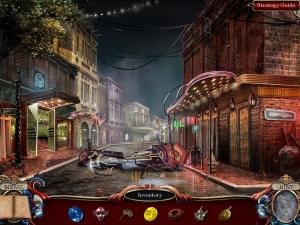 Despite the festivities, there’s just something about Mardi Gras that can make a person’s skin crawl. Maybe it’s the anonymity behind bizarre masks. Or maybe it’s the fog that knocks everyone into a paralyzed unconsciousness and removes all traces of their face. Well, at least in Vast Studios’ Shattered Minds: Masquerade, anyway. As a detective called in to investigate this mysterious phenomenon, it’s your task to track down the “Amazing Visage”, magician and impersonator, a “man of a thousand faces” who seems to be behind the surreal disaster that’s befallen New Orleans. Along the way, however, you’ll also have to contend with a masked family of twisted villains who seek revenge for the destruction of their mansion.
Despite the festivities, there’s just something about Mardi Gras that can make a person’s skin crawl. Maybe it’s the anonymity behind bizarre masks. Or maybe it’s the fog that knocks everyone into a paralyzed unconsciousness and removes all traces of their face. Well, at least in Vast Studios’ Shattered Minds: Masquerade, anyway. As a detective called in to investigate this mysterious phenomenon, it’s your task to track down the “Amazing Visage”, magician and impersonator, a “man of a thousand faces” who seems to be behind the surreal disaster that’s befallen New Orleans. Along the way, however, you’ll also have to contend with a masked family of twisted villains who seek revenge for the destruction of their mansion.
The game plays out like most deserted town hidden object adventures, though its few remaining denizens are what help this game stand out. The Boudreaux family members appear sequentially as you progress through the city, each wearing a distinctive mask you’ll need to collect, and each with a devious plot to wreak havoc. All fully voiced, these “shattered minds” are genuinely insane, but in a completely cool, detached way as if completely disconnected from reality. From the botanist who unleashes a formula that causes plants to grow to disastrous sizes to the artist who seeks to make a truly explosive masterpiece, or merely a jealous would-be lover who booby traps her obsession’s wedding, it’s a wonderfully sadistic lot. They lash out because they must, not because they’re evil. (Or so they think.) Unfortunately, the twitchy-eyed Visage is the least threatening of the bunch. He may hold the most power to destroy, but he’s the least menacing in wielding it.
The character models do a nice job of giving these masked villains an eerie presence, and many other macabre touches abound, from ethereal skulls emerging from the mist to preserved bodies in liquid holding tanks. Then there are all the faceless victims you encounter, some of which you’ll need to view up close and (im)personal. Locations include the likes of a casino, an art gallery, a hotel and theater, and of course you’ll have the chance to wander Bourbon Street both above and below ground. Some scenes are nicely designed, but others feel rather stark in comparison, and the somewhat washed-out technical quality (at least on a widescreen monitor) do the latter no favours. The music is something of a let-down as well. The light jazz and film-noir-inspired scores are pleasant enough to listen to, but always seem at odds with the grim circumstances. The mood fares better when it allows ambient sounds during lengthy periods of silence to accompany the action.
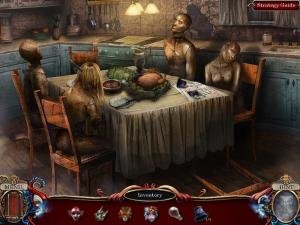 As you attempt to fix slot machines, disable security cameras, and mix deadly plant-killing chemical formulas, you must collect numerous inventory items as you go. Most have intuitive uses, but you’ll gather many before you ever know you need them. Some of these come from standard hidden object searches, with one or two interactive items per list. Thankfully, no hunts repeat or are secretly activated, avoiding the bloated repetition of so many casual games. In fact, the game does a good job of shepherding you along its path without feeling overly linear, always offering a handful of screens per area to explore, the hint button advising you if there’s anything currently solvable on any given screen. There are plenty of standalone puzzles as well, most of which consist of familiar tropes like Lights Out, cryptic combination codes, and rotating pieces into place. Several are repackaged alignment tasks, whether levers, dials, or slots, and a couple involve pipes connections, including the climactic challenge that makes you start all over again if you accidentally click out of it.
As you attempt to fix slot machines, disable security cameras, and mix deadly plant-killing chemical formulas, you must collect numerous inventory items as you go. Most have intuitive uses, but you’ll gather many before you ever know you need them. Some of these come from standard hidden object searches, with one or two interactive items per list. Thankfully, no hunts repeat or are secretly activated, avoiding the bloated repetition of so many casual games. In fact, the game does a good job of shepherding you along its path without feeling overly linear, always offering a handful of screens per area to explore, the hint button advising you if there’s anything currently solvable on any given screen. There are plenty of standalone puzzles as well, most of which consist of familiar tropes like Lights Out, cryptic combination codes, and rotating pieces into place. Several are repackaged alignment tasks, whether levers, dials, or slots, and a couple involve pipes connections, including the climactic challenge that makes you start all over again if you accidentally click out of it.
The streamlined nature of the adventure, plus the absence of repetitive filler, do result in a fairly short game, as you can reach the end in well under three hours. The finale is super-rushed but offers a reasonably satisfying outcome. Whatever goodwill the main game has achieved gets wasted by the Collector’s Edition “bonus” gameplay, however. Not only does it commit the very sins the main game avoids (repetitive hidden object searches, solving the same puzzles multiple times in a row), the obtuse final puzzle is so poorly clued (or explained) that I never did figure it out. It also spins off the Boudreaux family story in an unusual direction that raises more questions than it answers. And to add insult to injury, the final cutscene does nothing to bring closure, merely taunting of unfinished business. If you’re interested in the premise, then, I definitely recommend the standard version only. It may not be very original, but some solid casual gameplay and some great villains help mask any deficiencies.
Death Under Tuscan Skies: A Dana Knightstone Novel
by Jack Allin
Boomzap’s Death Under Tuscan Skies: A Dana Knightstone Novel should more appropriately be subtitled “A Dana Knightstone Short Story”. Not because the game itself is short by any means, but by the time you’re finished with its nearly wall-to-wall puzzles, there really isn’t much room left for narrative. The setup is nearly identical to the first game, Death at Fairing Point, but this time Dana is visiting Italy following the rousing success of her latest book. After giving a lecture at a university, Dana spots a frightened ghost who pleads with Dana to help her. And so begins another cross-country investigation into a century-old tragic tale of star-crossed lovers, with protective fathers, jealous colleagues, stunning betrayals, and an invaluable medical discovery all playing their part. It’s a solid premise for a supernatural whodunit, though ultimately it’s just a flimsy excuse to deliver puzzle after puzzle after puzzle (sometimes immediately, with puzzles within others).
 A puzzlefest may sound like a dream for some, but it isn’t without its problems. Many of the puzzles are recycled standards: jigsaws to swap and rotate, Lights Out buttons to press, sliders to manipulate, and circuits to align, some of which are thinly disguised and repeated later. Other types are common as well, but at least show a measure of creativity in the presentation, thankfully avoiding twiddleware for the most part. Here you’re often matching symbols, numbers, patterns and themes in varying ways, frequently in some combination together. Even an otherwise routine pairs-elimination task means adding coded numbers first to determine the correct sequence to remove them, adding a welcome layer of complexity. Strangely, however, the puzzles tend to be either super-easy or insanely obtuse (mainly due to insufficient instructions), with little middle ground in between. Given the frequency with which the puzzles occur, the result feels more like a scenic tour marred by endless speed bumps (and a horrendously dull gentle piano soundtrack) than a riveting murder investigation.
A puzzlefest may sound like a dream for some, but it isn’t without its problems. Many of the puzzles are recycled standards: jigsaws to swap and rotate, Lights Out buttons to press, sliders to manipulate, and circuits to align, some of which are thinly disguised and repeated later. Other types are common as well, but at least show a measure of creativity in the presentation, thankfully avoiding twiddleware for the most part. Here you’re often matching symbols, numbers, patterns and themes in varying ways, frequently in some combination together. Even an otherwise routine pairs-elimination task means adding coded numbers first to determine the correct sequence to remove them, adding a welcome layer of complexity. Strangely, however, the puzzles tend to be either super-easy or insanely obtuse (mainly due to insufficient instructions), with little middle ground in between. Given the frequency with which the puzzles occur, the result feels more like a scenic tour marred by endless speed bumps (and a horrendously dull gentle piano soundtrack) than a riveting murder investigation.
If you don’t mind slamming the brakes every five minutes, there is some lovely scenery to admire, as Dana travels to a quaint Italian town, a remote monastery, and an elegant cathedral. Though the perspective is often disappointingly distant, the artwork is crisp, which is useful since there are no hotspot highlights to help you out. There is a hint button that spells out what to do next if you’re stuck, which may happen as the objectives are often fairly random and neither the task list nor journal are particularly informative. There is inventory to collect, but usually it’s multiple figurines, lettered buttons, coins, and even plastic organs to initiate yet another completely contrived puzzle. Some feel better integrated, like sterilizing lab equipment and developing film, but you’re just as likely to be fixing a mechanical pigeon at a toy shop or sorting a vendor’s postcards. There are maybe a dozen hidden object tasks to complete, but only half of these are traditional searches for random lists of items. The others include finding silhouetted objects, locating matching image fragments, collecting item sets, and identifying discrepancies. None are repeated, and their judicious use throughout prevents them from ever feeling tiresome.
Depending on your puzzle-solving ability (or puzzle-skip tendency) and difficulty level chosen, it should take at least four hours to complete the main adventure, which wraps up the mystery in a rather superficial but satisfactory fashion. The Collector’s Edition bonus chapter adds another hour or so to that, offering more of the same puzzle-dense, HOG-lite gameplay. The storyline here feels entirely unnecessary, picking up after the original mystery and veering off in a silly direction involving a secret society. There are a couple macabre locations that are fun to explore, but that’s about the best the expansion has to offer. But there are lots more puzzles! And did I mention the puzzles? I don’t want to sound like I’m condemning puzzle-centric gameplay, but this is a novelist you’re playing. Unfortunately, what little story there is gets parceled out in voice narration alone as Dana connects the dots of scant information between each of the game’s six chapters. Presumably Dana Knightstone pads out her own books with far more details than we get here, or it would be a very thin novel indeed. There’s plenty of gameplay bang for your buck, but if it’s a ghostly romance mystery you’re after, you’d best look elsewhere, as you’ll mainly find puzzles under the Tuscan Skies.
Mystery Stories: Mountains of Madness
by Jack Allin
A novella by H.P. Lovecraft provided the inspiration for cerasus.media’s Mystery Stories: Mountains of Madness, which sends players into the eponymous wintry mountain range in search of an expedition team that’s gone missing. When the team is found dead alongside alien creatures frozen in the ice – some of whom have been dissected – Lynn Morgan and William Dyer take turns working their way through a series of icy caverns and bizarre technology as they seek to discover the mystery of the Elder Gods and the deadly Shoggoth slaves they created. It’s a very short trip, however, and doesn’t provide many answers besides “how fast can I get out of here?”
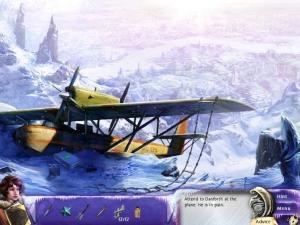
Gameplay is entirely traditional for a hidden object adventure, though the item hunts list only 6 objects at a time out of as many as 27 in total. While you do have to repeat the same scenes multiple times, the items you’ve already gathered remain missing on return visits, making each subsequent hunt much easier. Inventory puzzles tend to feel rather unintuitive, as you’re often collecting crystals or broken fragments to power who-knows-what kinds of bizarre equipment. Hotspots and even exits can be a little hard to make out, but an “advice” button will give you a nudge toward your current objective, and the hint feature will point you directly to the next achievable task. Standalone puzzles include some rather cryptic pipes challenges, rotating jigsaws, line-matching and tile-smashing, but there’s nothing here that will give you much difficulty, at least on the easier setting.
The snow-covered locale allows for little visual variety, as the only thing deviating from the endless screens of cool blues and whites is a lone underground geyser and a hokey-looking smoke monster of some sort. A few locations do allow for optional parallax scrolling, however, which is a nice touch that would have been welcome throughout. A wooden narration represents the only voice acting in the game (particularly odd when you’re listening to a static-filled, crackling “voice” recording of subtitles-only), while the soundtrack rounds out the production with a collection of pleasant tracks. Mind you, “pleasant” isn’t really the vibe the story is projecting, so some haunting, ominous tunes are conspicuous by their absence. Between chapters you’ll learn a bit about the strange visitors and the tragedy that occurred, but the measly two hours of play time allows only a very cursory look. Given its ease and short length, unless you’re a Lovecraft fanatic there really isn’t enough here to recommend wholeheartedly. For everyone else, “because it’s there” just isn’t a good enough reason to climb these mountains of madness.
And with that, we're done! That's it, we're through, the fat lady has sung. It's been a blast following the rapid transformation of casual games into more fully-featured adventures this past year, but the time has come to say goodbye. Why the end of Casual Collection? Like most things, it's a combination of reasons. Who could have foreseen that the simple hidden object genre would evolve so quickly, so fully into a flood of adventure hybrids? So much so, there are far too many games, far too few people and time to deal with them all. Add to that a decreasing availability of review copies of late, and such comprehensive coverage is no longer possible. Besides, there's such an inherent degree of sameness to the vast majority of games, it's starting to feel like we're reviewing the same six or seven games over and over again.
We regret having to bring this series to a close, and we may yet revisit the possibility of a scaled-back version at some point in future, but for now it's time for a much-needed break. That will make some people very happy (though if you're reading this, you're likely not one of them), but we know others will be disappointed. Rest assured that any lite adventures that move beyond the traditional hidden object adventure formula will continue to get our complete, undivided attention. And hey, maybe more casual developers will get the hint and raise their games to a whole different level from here on out. We can always hope, can't we? In this rapidly-changing field, who knows what the casual space will look like a year or two from now?
Note: Adventure Gamers is a Big Fish Games affiliate.



